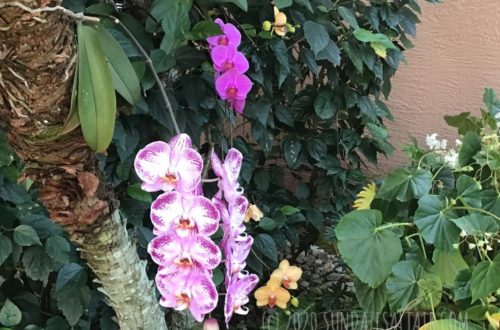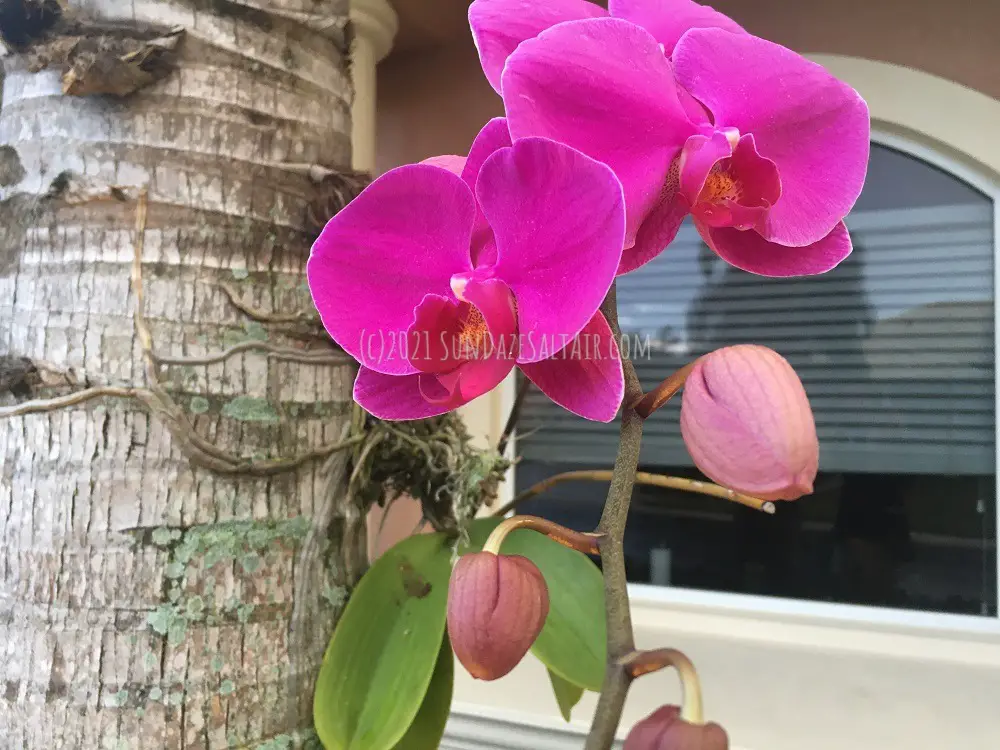
How To Get Your Phalaenopsis to Bloom in Winter
Tips & Tricks to Help a Moth Orchid Realize Its Seasonal Blooming Potential
A blooming Phalaenopsis is a beautiful sight indeed… especially when those first buds appear on your Phalaenopsis in the chill of mid-winter. Of all orchid types, Phalaenopsis is actually one of the easiest orchids to rebloom. There are, however, a number of factors at play when it comes to blooming a Phalaenopsis, or “moth orchid,” in winter. Believe it or not, some of these factors are actually within your control. Among these, surprisingly, is the “internal clock” within a Phalaenopsis that lets the orchid know the time has come to prepare to bloom. How exactly can you influence this? Well, read on because if your “Phael” is struggling to rebloom this winter, it may very well be that certain artificial conditions inside your home are hindering this important natural seasonal process. Let’s take a look at how you can influence your Phalaenopsis to bloom by triggering its natural rhythms to induce the most beautiful blooms even in the dead of winter and early spring.
**Note: This post contains affiliate links for which a small commission may be earned if you decide to make a purchase through a link.
How To Get Your Phalaenopsis to Bloom in Winter Tip #1: Make Sure Your Phalaenopsis Is Healthy
The Importance of Phalaenopsis Health to Trigger Reblooming
In order to have the energy to produce the external beauty of blooms, your Phalaenopsis must first be in good health. A sickly orchid, such as one with dying leaves or shriveled roots will not be a good contender for blooming no matter the season. Instead, an orchid that is struggling will be using all of its energy to stay alive, and rightly so. Once it regains its vitality, there may be plenty of flowers in your orchid’s future.
The Importance of Phalaenopsis Roots
Like the heart and circulatory system is to humans, so is the root system to orchids. Roots absorb moisture and nutrients from the surrounding environment, so the more roots, the better. In order for your Phalaenopsis to even consider flowering, it will need to have a good root system established first. Of course, many orchids at one time or another, will have weak or unhealthy root systems. Often arising from poor potting conditions and neglect, if you grow or have grown orchids you have likely encountered your fair share of unhealthy orchid roots at some point. The last thing a sick orchid wants to do is produce flowers, if they are even capable of producing any.
How Can You Prevent or Repair Damaged Roots?
To prevent or revive damaged roots, be sure to do the following…
Avoid Damaged Roots with a Periodic Repotting & Maintenance Routine
Be proactive by making sure you regularly inspect your orchid’s potting conditions and repot your Phalaenopsis as needed. Find out exactly how, when and why you should repot your Phalaenopsis here in this post…
Or… Avoid Potting Altogether & Grow Your Phalaenopsis Without a Medium or Pot to Give It What It Loves,..
Three Alternatives to Growing Your Orchids in Pots:
Learn how & why to grow your orchid bare root without a medium or pot here…
Discover the many benefits of attaching your orchid to a tree here…
Try growing your orchids in hanging baskets & discover why they love it here…
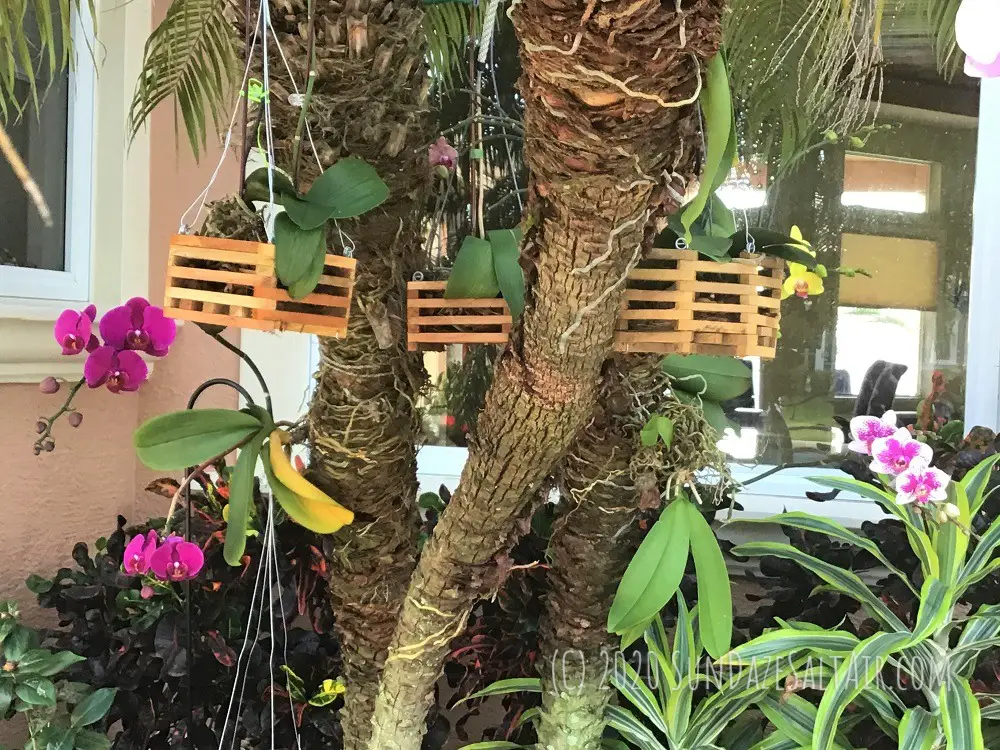
Revive Any Damaged Roots with a “Rehab” Routine
Whether they appear on store-bought orchids that have languished in the same pot too long or even as a result of a lapse in your own orchid care routine, damage to roots does happen. However, they need not be fatal to your plant if you catch them early and rehab them in time. With some TLC and a consistent care routine that focuses on new root and leaf growth, a Phalaenopsis can regain its vitality to once again produce exquisite blooms. Here are a few different methods to stimulate root (and leaf) growth on your orchid:
TIP! How To Gauge the Health of Your Phalaenopsis by Its Leaves
Did your orchid grow a new leaf in the last few months? If so, lucky you! You may anticipate a flower spike is in your near future! Healthy leaves absorb more energy from the sun and are able to convert this energy into life-sustaining nutrients. The presence of a new large and healthy leaf, as well as an emerging robust root, is a great sign your Phalaenopsis is in peak health, possessing the energy and vitality it needs to bloom.
Bottom-line: Consistent Care Is Essential to Trigger Blooming in A Phalaenopsis
While an orchid with inadequate roots systems may struggle to bloom, don’t give up. Once you get into a consistent routine that encourages root growth, eventually your orchid may be healthy enough to direct its energy to producing flower spikes.
While the health of your Phalaenopsis is critical, there are other, more external factors that also influence the blooming of a Phalaenopsis….
How To Get Your Phalaenopsis to Bloom in Winter Tip #2: The Seasonal Blooming Cycle of a Phalaenopsis
Can the Artificial Conditions Inside a Home Hinder the Seasonal Blooming of a Phalaenopsis?
Many people don’t know that the Phalaenopsis orchid blooms seasonally. Similar to a number of flowering plants, the shorter, cooler days that countdown to winter actually trigger an “internal clock” in the Phalaenopsis to prepare to bloom. For those of you growing a Phalaenopsis indoors, this raises questions about how the constant artificial light and consistent temperatures inside a typical home may affect, and possibly hinder, a seasonal Phalaenopsis blooming cycle.
Fun Fact! Why Your Phalaenopsis Is Not Blooming in Summer
If your Phalaenopsis is not blooming in summer months, know that the hot summer is typically when your plant focuses on growing new roots and leaves – the infrastructure, if you will, of a healthy orchid. The warmer daytime temperatures in summer actually inhibit flower development in a Phalaenopsis.
The flowering Phalaenopsis you find during the summer in stores, for example, have often been “forced” to bloom and will revert to their normal blooming patterns once in their new homes. So don’t be discouraged if your Phalaenopsis is not blooming like the ones you see in stores throughout the year.
Bottom-line:
While your Phalaenopsis is most likely to grow roots and leaves in summer and early fall, it most likely to establish a flower spike in late fall. The spike will grow throughout the winter with blooms appearing in late winter and early spring.
Let’s find out what you can do to help a Phalaenopsis experience its natural rhythms to realize its full winter blooming potential. But first, here is a great alternative way to grow am orchid inside your home without using pots or potting medium….

How to Create the Conditions a Phalaenopsis Needs to Trigger Winter Blooming
If artificial conditions inside a home can hinder this natural process, what can you do to recreate the conditions a Phalaenopsis needs to trigger its winter blooming cycle?
Temperature
Similar to other flowering plants such as the bougainvillea and the Christmas cactus, Phalaenopsis is a plant that needs a temperature drop to trigger winter blooming. Why? Phalaenopsis has a sensitive internal clock that relies on a drop in temperature to let it know blooming season is fast approaching. The drop in temperature that occurs naturally beginning in autumn, especially at night, is a tremendous inducement for a Phalaenopsis to bloom.
As a result, a Phalaenopsis that gets to experience these seasonal temperature changes will typically start flowering just after the New Year in January. Hence why, in mid-winter, you may observe an inflorescence growing out of your Phalaenopsis.
Bottom-line: Constant temperatures indoors may inhibit the seasonal blooming of a Phalaenopsis.
If Your Phalaenopsis Is Indoors, Expose It to Autumn Temperature Changes
To recreate the drop in temperature a Phalaenopsis relies on to trigger blooming, starting in late autumn, as nighttime temperatures start to drop into the 50’s, you should allow your Phalaenopsis to spend some time outside. Just try to keep your orchid out of direct sunlight during the day. Phalaenopsis generally needs to experience cool temperatures that range from 55 to 65 degrees F to trigger their internal readiness to bloom. Of course, relocate your orchid indoors if the temperature drops below the 50’s for any extended time.
How Long Should You Expose Your Phalaenopsis to A Temperature Drop to Trigger Blooming?
For best results, allow your Phalaenopsis to enjoy the autumn chill for a couple of weeks, on average anywhere from two weeks to one month should do the trick. Again, be sure to bring your orchid inside if there is any threat of frost or freezing temperatures. After two to four weeks of “chilling” outdoors, relocate your orchid back to its usual environment. By this time, you may actually begin to see a what looks like the green tip of a new root forming. Fantastic!
What A New Flower Spike Looks Like
Before long, this green, “knobby” tip should grow into a long, upward pointing stem with buds on it which is known as an inflorescence. Inflorescence is also another name for a tiny flower spike and that is exactly what you want to see shooting up after your orchid’s exposure to lower temperatures. Congratulations, you have successfully induced your Phalaenopsis to bloom!
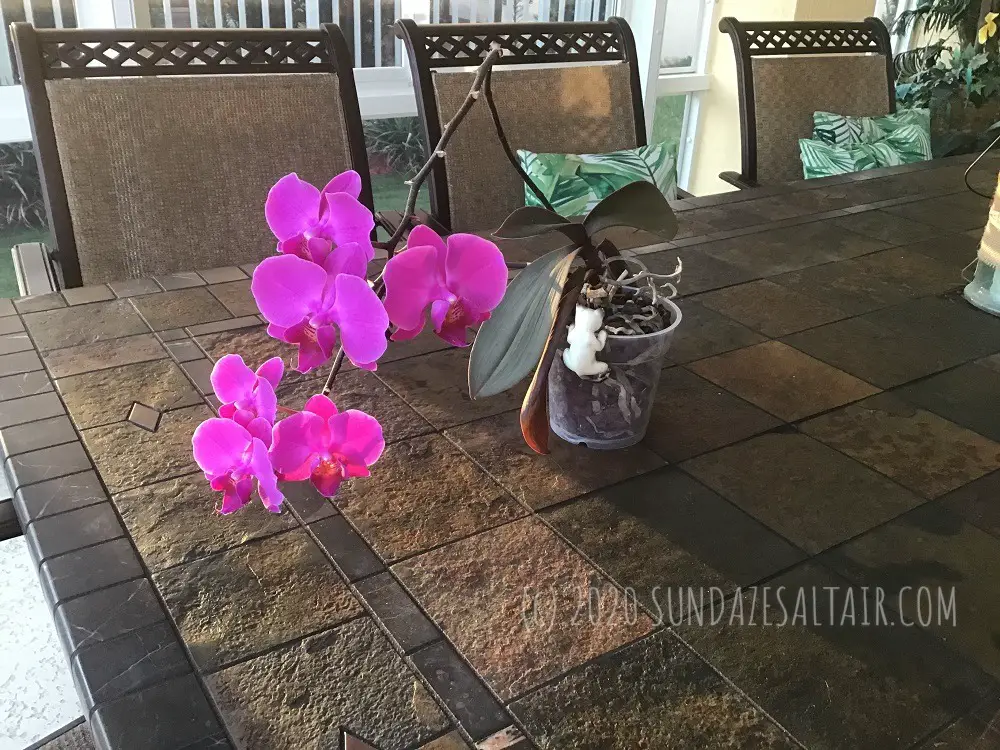
What If Your Phalaenopsis Does Not Show Any Visible Changes?
Even if you don’t see any observable changes in your Phalaenopsis, after a few weeks of experiencing the brisk autumn temperature drop, you should relocate your orchid back to its usual environment. Rest assured, it is only a matter of time before you notice an inflorescence, aka a future flower stem, shooting up.
TIP! When placing your orchid outside, be sure to place it on a partially covered patio or porch where you can keep an eye on it and shield it from too much sun or autumn storm and rain exposure.
What If You Can’t Place Your Phalaenopsis Outdoors?
If possible, try placing your Phalaenopsis is a cooler room with a temperature that drops to 55 to 65 degrees F at night. Also, consider placing your orchid near a cool spot in the room such as near a window that is away from any heat sources.
Still Not Seeing a New Flower Spike?
Try moving your Phalaenopsis to a new location to give your orchid brighter light and more exposure to chilly temperatures.
Conclusion: How to Get Your Phalaenopsis to Bloom in Winter & Early Spring: Follow These Tips to Trigger Seasonal Flower Production in Your Phalaenopsis
All it takes is a bit of patience and a little know-how to understand exactly what your Phalaenopsis needs. Be sure to bookmark and share these tips and tricks so you can provide the conditions a Phalaenopsis needs to trigger a lush winter and early spring bloom. Be sure to share these tips with your friends so every orchid lover can experience a seasonal Phalaenopsis flower extravaganza…
********
What are your best tips to coax lush blooms out of your ‘Phaels? Share your favorites in the comments!


You May Also Like
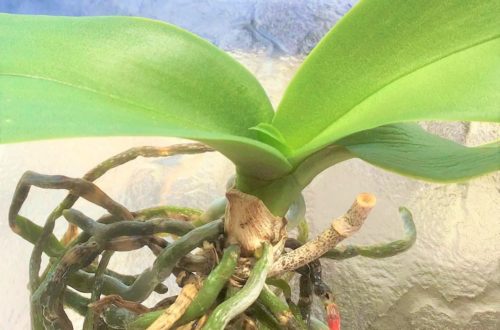
What Do Red Root Tips On An Orchid Mean? Why Your Orchid Has A Red Root Tip, & Should You Be Worried?
August 18, 2021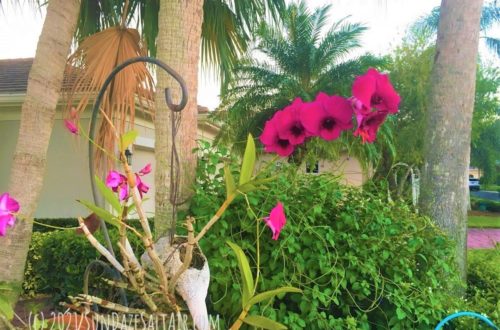
How To Grow Orchids Bare Root Without A Medium Or Pot
November 6, 2021